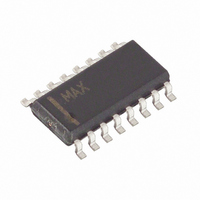DS28E04S-100+ Maxim Integrated Products, DS28E04S-100+ Datasheet - Page 30

DS28E04S-100+
Manufacturer Part Number
DS28E04S-100+
Description
IC EEPROM 4KBIT 16SOIC
Manufacturer
Maxim Integrated Products
Datasheet
1.DS28E04S-100.pdf
(36 pages)
Specifications of DS28E04S-100+
Format - Memory
EEPROMs - Serial
Memory Type
EEPROM
Memory Size
4K (256 x 16)
Interface
1-Wire Serial
Operating Temperature
-40°C ~ 85°C
Package / Case
16-SOIC (3.9mm Width)
Organization
4 K x 1
Interface Type
1-Wire
Supply Voltage (max)
5.25 V
Supply Voltage (min)
2.8 V
Maximum Operating Current
1 mA
Maximum Operating Temperature
+ 85 C
Mounting Style
SMD/SMT
Minimum Operating Temperature
- 40 C
Lead Free Status / RoHS Status
Lead free / RoHS Compliant
Voltage - Supply
-
Speed
-
Lead Free Status / Rohs Status
Lead free / RoHS Compliant
Figure 17. Noise Suppression Scheme
CRC GENERATION
With the DS28E04-100 there are two different types of CRCs. One CRC is an 8-bit type and is stored in the most
significant byte of the 64-bit ROM. The bus master can compute a CRC value from the first 56 bits of the ROM and,
if none of the address inputs is connected to GND, compare it to the value stored within the DS28E04-100 to
determine whether the ROM data has been received error-free. If any of the address pins are connected to GND,
the bus master can calculate the CRC based on an all 1s external address field to determine whether the non-
external address ROM data has been received error-free. The equivalent polynomial function of this CRC is X
+ X
the ROM.
The other CRC is a 16-bit type, generated according to the standardized CRC16-polynomial function x
+ 1. This CRC is used for fast verification of a data transfer when writing to or reading from the scratchpad or when
reading from the PIOs. In contrast to the 8-bit CRC, the 16-bit CRC is always communicated in the inverted form. A
CRC generator inside the DS28E04-100 chip (Figure 18) calculates a new 16-bit CRC, as shown in the command
flow chart (Figure 9). The bus master compares the CRC value read from the device to the one it calculates from
the data, and decides whether to continue with an operation or to reread the portion of the data with the CRC error.
With the Write Scratchpad command, the CRC is generated by first clearing the CRC generator and then shifting in
the command code, the target addresses TA1 and TA2, and all the data bytes as they were sent by the bus
master. The DS28E04-100 transmits this CRC only if E4:E0 = 11111b, i.e., the end of the scratchpad is hit.
With the Read Scratchpad command, the CRC is generated by first clearing the CRC generator and then shifting in
the Command code, the target addresses TA1 and TA2, the E/S byte, and the scratchpad data as they were sent
by the DS28E04-100. The DS28E04-100 transmits this CRC only if the reading continues through the end of the
data written in the previous write scratchpad sequence. Example: if one writes a single byte to the scratchpad and
then reads the scratchpad, one will receive a CRC of the command, TA1, TA2, and the data byte.
With the initial pass through the PIO Access Read command flow, the CRC is generated by first clearing the CRC
generator and then shifting in the command code followed by 32 bytes of PIO pin data. Subsequent passes
through the command flow generate a 16-bit CRC that is the result of clearing the CRC generator and then shifting
in 32 bytes read from the PIO pins. For more information on generating CRC values, refer to Application Note 27.
4
V
+ 1. This 8-bit CRC is received in the true (noninverted) form. It is computed at the factory and hardcoded into
HY
V
V
PUP
0V
TH
Case A
t
GL
Case B
t
REH
30 of 36
t
REH
t
Case C
GL
16
+ x
15
8
+ X
+ x
5
2












